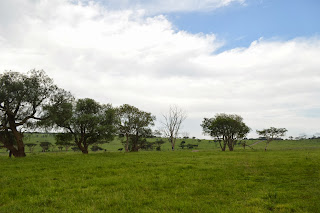As a disclaimer - Eric didn't proof read this!
I rounded today with the chief of medicine and learned the history of the hospital. Edendale Hospital was designed as a 900 bed public hospital built in the 1950s before Apartheid. When the laws came into existence it turned into a public black hospital. Funds were not allocated for support nor resource development and it essentially remained untouched until the late 1990s/early 2000s when at the end of Apartheid a CT scanner and new electronic core/pathology lab was added. A very small ED has since been established with a main entrance still undergoing renovation and current planned renovations include a new psych department and a renovated area for medical evaluations prior to admission. At least in medicine, computers exist only on doctor's smart phones which they use to connect to the core lab to see results.
Entering the wards feels like entering the 1950s. The medicine wards on the 5th floor are separated by sex and essentially look identical. There are approximately 6 sections separated by chest high brick walls and each section has 8 beds. There are no curtains, private restrooms, tvs, phones or privacy. As a patient, you get your bed, hospital gowns, food, a small night table and of course medical treatment. Rounding with the chief of medicine was a very pleasant experience where we discussed the differences in test ordering and time to completion. For example, a CT and MRI can take a maximum of one day at CUMC (which we still find difficult to tolerate) whereas in SA it can take weeks. Because of this, endocarditis is ruled out by stethoscope, not echo. Bilateral crackles and no fever is pulmonary edema and does not require a CXR. While I cannot comment on exam skill level, I can say there is a much higher level of comfort using exam skills to rule in or out disease.
I rounded today with the chief of medicine and learned the history of the hospital. Edendale Hospital was designed as a 900 bed public hospital built in the 1950s before Apartheid. When the laws came into existence it turned into a public black hospital. Funds were not allocated for support nor resource development and it essentially remained untouched until the late 1990s/early 2000s when at the end of Apartheid a CT scanner and new electronic core/pathology lab was added. A very small ED has since been established with a main entrance still undergoing renovation and current planned renovations include a new psych department and a renovated area for medical evaluations prior to admission. At least in medicine, computers exist only on doctor's smart phones which they use to connect to the core lab to see results.
Zebras
Entering the wards feels like entering the 1950s. The medicine wards on the 5th floor are separated by sex and essentially look identical. There are approximately 6 sections separated by chest high brick walls and each section has 8 beds. There are no curtains, private restrooms, tvs, phones or privacy. As a patient, you get your bed, hospital gowns, food, a small night table and of course medical treatment. Rounding with the chief of medicine was a very pleasant experience where we discussed the differences in test ordering and time to completion. For example, a CT and MRI can take a maximum of one day at CUMC (which we still find difficult to tolerate) whereas in SA it can take weeks. Because of this, endocarditis is ruled out by stethoscope, not echo. Bilateral crackles and no fever is pulmonary edema and does not require a CXR. While I cannot comment on exam skill level, I can say there is a much higher level of comfort using exam skills to rule in or out disease.
The prevalence and incidence of disease also plays a huge
role in diagnosis. Given the high HIV
burden, LPs are done like blood draws and a brisk flowing CSF is assumed to be
crypto meningitis until proven otherwise.
A CXR with multifocal pneumonia is miliary TB because of possible small
nodular opacities. On rounds, I also noticed
the high burden of ETOH abuse and THC but very few patients because of cost use
heroin or cocaine. The THC is grown by
farmers in the surrounding area but in Lesotho the farmers alternate a row of
corn with a row of THC to prevent police airplanes from seeing the crop.
No procedures today L. I was going to do a blood draw but then
realized….That is the one thing I don’t need practice on



